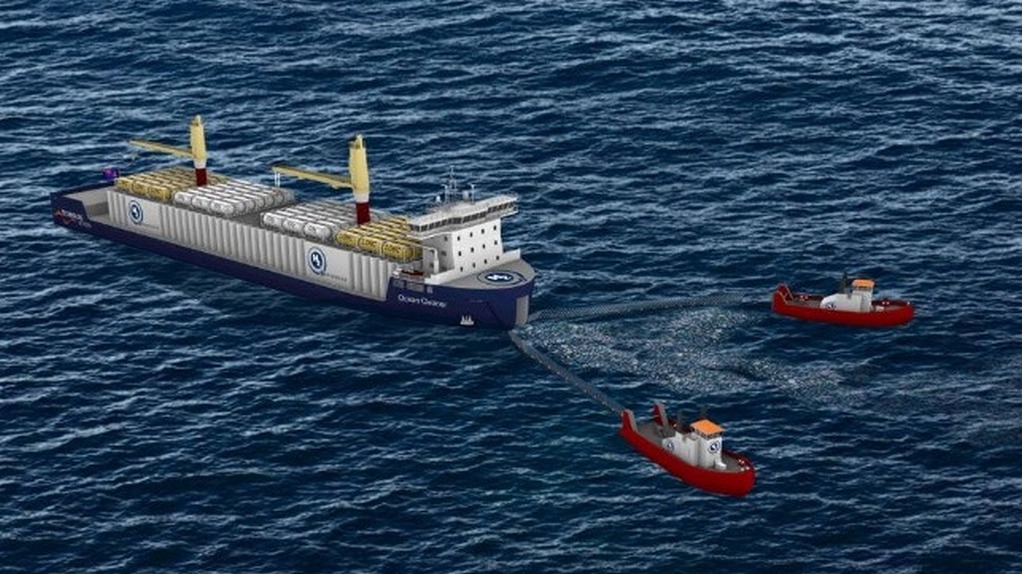H2-Industries, a startup company developing hydrogen technologies, working with naval architecture company TECHNOLOG Services has developed a novel concept ship that they say could collect plastic waste from the world’s oceans and converts it into hydrogen.
The ship is being designed to be more than 490 feet in length, with the exact size to be clarified at the design stage, depending on optimal storage capacity. The plan is for the ship to travel at four knots with the waste plastic collected by two smaller vessels towing a two-mile net that funnels the waste from the surface and up to depths of 30 feet. The vessel would use a novel open bow design that allows the collected plastic waste to be fed onto conveyors and into the storage hold. The waste would be converted into hydrogen using a thermolysis process that the H2-Industries is developing for plants on shore.
“It is becoming increasingly clear that the shipping industry can make a positive impact on reducing global emissions. At H2-Industries, the plan is to help decarbonize industry and power generation, while cleaning up our water resources and converting pollutants into an energy source,” said Michael Stusch, CEO of H2-Industries.
For every 600 kg of waste collected, Stusch says approximately 100 kg of hydrogen can be produced and then, stored in a liquid organic hydrogen carrier, a fluid that can carry hydrogen and can be shipped in 20-foot containers. These containers would be transferred to smaller vessels by onboard cranes for delivery to shore.
The ship itself would run on electric motors using the hydrogen-charged fluid which is charged and discharged using proprietary catalyst technology developed by H2-Industries. The fluid, known as LOHC, produced on board would be used as the fuel aboard the ship and create electricity using H2-Industries’ 19-inch eRelease racks. Each rack will hold 48 KW of installed power and there will be multiple racks to deliver the approximately 2 MW that a ship of this size would require. H2-Industries developed the technology and intends to also promote it for use on cruise ships, supertankers, and large containerships. H2-Industries reports it has received preliminary approval to build its first LOHC hub in East Port Said in Egypt and is currently in discussions with more than 20 countries and, as well, with several ports worldwide.
One constraining factor for production the company notes is the volume of plastic feedstock. One rotary kiln they said can handle 600 kgs of waste every hour and that will generate approximately 100 kgs of hydrogen. Each ship will be designed to be fitted with multiple kilns to match the speed of plastic collection. The concept projects that each ship would collect plastic for around a year in one location before moving on to another water waste site. To ensure no marine wildlife is endangered during the waste collection process, the vessel will employ industry-tested technology developed for the seawater intake for desalination plants designed to protect wildlife and habitats.
H2-Industries expects that each ship could be built within roughly 24 months, once it has raised sufficient investments.
Source: Maritime Executive
Tags: Emissions, H2 Industries, Hydrogen, Plastic Waste, TECHNOLOG Services



Recent Posts
DNV Grants Approval in Principle for New Ammonia Bunkering Vessel Design
Proteus Launches Modular Hydrogen Fuel Cell System for Maritime Sector
Van Oord Unveils Boreas, World’s Largest and Most Sustainable Offshore Wind Installation Vessel
New methanol-fuelled vessel ‘Berlin Maersk’ to enter service
NMPA wins greentech global environment award
CMA CGM in negotiations with Indian shipyards for LNG-powered shipbuilding
L&T to Develop Green Hydrogen and Ammonia Projects in Kandla
Pan Ocean Orders Two Eco-Ready VLCCs from HD Hyundai Heavy Industries